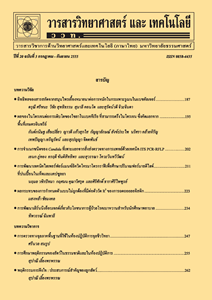การพัฒนาผลิตภัณฑ์ผงปรุงรสจากลำไย
Main Article Content
Abstract
Abstract
Seasoning powder (SP) is mixtures of different synthetic substances used primarily in cuisine for improving test of food. Occasionally, utilization of low-grade longan as raw material for producing seasoning powder is an interesting option, and value added for longan farmers. It is really an aromatic, delicious and also fairly sweet fruit. The objective of this research was to investigate the suitable ratio of sodium chloride (NaCl), sugar and longan flesh powder (LFD) on SP by mixture design. In addition, the effects of NaCl replacement with potassium chloride (KCl) on the sensory evaluation was investigated. The results showed that 25 % NaCl, 35 % sugar and 40 % LFD were the suitable ratio for seasoning powder. In term of NaCl replacement, increased KCl had effects on saltiness, bitterness and overall liking. On the other hand, the overall flavor and sweetness of SP were not significant (p > 0.05). At 25 % KCl had the highest overall liking scores that was an appropriate ratio for producing seasoning powder. In conclusion, the optimum formulation of SP contained of 32.0 % LFD, 28.0 % sugar, 15.0 % NaCl, 5 % KCl, 16.0 % fish powder, 2.0 % pepper powder, and 2.0 % garlic powder, respectively.
Keywords: longan; NaCl; KCl; seasoning powder
Article Details
References
[2] ศูนย์สารสนเทศการเกษตร, ลำไย, แหล่งที่มา : http://www.oae.go.th/ewt_news.php?nid=9749, 24 มิถุนายน 2560.
[3] Choo, W.K., 2000, Longan Production in Asia, Food and Agriculture Organization of the United Nations Regional Office for Asia and the Pacific, Bangkok, Thailand, 14 p.
[4] Gunawan-Puteri, M.D.P.T., Hassanein, T.R., Prabawati, E.K., Wijaya, C.H. and Mutuku-mira, A.N., 2015, Sensory characteristics of seasoning powders from overripe tempeh, a solid state fermented soybean, Proc. Chem. 14: 263-269.
[5] Soong, Y.Y. and Barlow, P.J., 2006, Quantification of gallic acid and ellagic acid from Longan seed and Mango kernel and their effects on antioxidant activity, Food Chem. 97: 524-530.
[6] Rangkadilok, N., Worasuttayayangkurn, L., Bennett, R. and Satayavivad, J., 2005, Identification and quantification of polyphenolic compounds in Longan (Euphoria longana Lam.) fruit, J. Agri. Food Chem. 53: 1387-1392.
[7] Woo, T.M. and Robinson, M.V., 2016, Pharmacotherapeutics for Advanced Practice Nurse Prescribers, F.A. David Company, Philadelphia, Pennsylvania.
[8] Stone, H., 1992, Manual on Descriptive Analysis Testing for Sensory Evaluation, ASTM International.
[9] Duncan, D.B., 1995, Multiple range and
multiple F tests, Biometrics 11: 1-42.
[10] AOAC, 2012, Official Methods of Analysis of Association of Official Agricultural Chemists. 19th Ed., Washington, District of Columbia.
[11] Yang, X., Yan, F., Huang, S. and Fu, C., 2014, Antioxidant activities of fractions from Longan pericarps, Food Sci. Tech. (Campinas) 34: 341-345.
[12] สำนักงานมาตรฐานผลิตภัณฑ์อุตสาหกรรม, 2547, มาตรฐานผลิตภัณฑ์ชุมชน (มผช. 494/2547) ผงปรุงรสอาหาร.
[13] Surin, S., Thakeow, P., Seesuriyachan, P., Angeli, S. and Phimolsiripol, Y., 2014, Effect of extraction and concentration processes on properties of Longan syrup, J. Food Sci. Tech. 51: 2062-2069.
[14] Lapsongphol, S., 2007, Effect of Drying Conditions on the Volatile Compounds and Phenolic Compounds in Dried Whole Longan and Longan Tea, M.Sc. Thesis, Silpakorn University, Sanamchandra Palace Campus, Nakhon Pathom, 112 p.
[15] Stanley, R.E., Bower, C.G. and Sullivan, G.A., 2017, Influence of sodium chloride reduction and replacement with potassium chloride based salts on the sensory and physico-chemical characteristics of pork sausage patties, Meat Sci. 133: 36-42.

